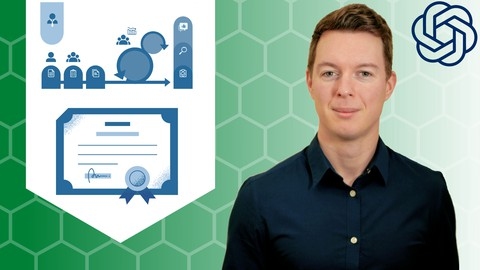Scrum is a highly effective Agile framework used to manage complex projects in an iterative and collaborative way.
It emphasizes teamwork, self-organization, and continuous improvement, making it a popular choice for software development, product development, and various other industries.
Mastering Scrum allows you to become a more efficient project manager, improve team communication, and deliver high-quality products in a timely manner.
Finding the right Scrum course on Udemy can be a challenge, as there are countless options available.
You want a program that’s comprehensive, engaging, and taught by experienced professionals who can guide you through the nuances of Scrum.
You also want a course that prepares you for certifications, if you’re aiming to advance your career in Agile project management.
After analyzing numerous courses, we recommend “Scrum Master Certification 2024 + Agile Scrum Certification” as the best overall course on Udemy.
This program provides a comprehensive overview of Scrum, covering the essential concepts, ceremonies, and artifacts.
The instructor guides you through the process with clear explanations, engaging examples, and helpful exercises, preparing you for both theoretical and practical understanding.
It also includes practice tests and valuable tips for passing the Scrum Master certification exam.
While “Scrum Master Certification 2024 + Agile Scrum Certification” is our top pick, we understand that every learner has unique needs.
We’ve curated a collection of other fantastic Udemy courses, tailored to different learning styles, career goals, and areas of specialization within Scrum.
Keep reading to explore our full list of recommendations and find the perfect Scrum course for your learning journey!
Scrum Master Certification 2024 + Agile Scrum Certification
You’ll start by learning about the traditional waterfall model and the problems it faced, which led to the birth of agile methodologies like Scrum.
The course then dives into the fundamentals of Scrum theory, including empirical process control, self-managing teams, and the Scrum values of commitment, courage, focus, openness, and respect.
Next, you’ll explore the three key roles in a Scrum team: the Product Owner, responsible for maximizing the value of the product; the Developers, who build the product increment; and the Scrum Master, who facilitates the Scrum process.
You’ll understand their accountabilities and how they collaborate to deliver a high-quality product.
The course covers the five Scrum events in detail: Sprint Planning, Daily Scrum, Sprint Review, Sprint Retrospective, and Product Backlog Refinement.
You’ll learn how to conduct these events effectively and understand their importance in the Scrum framework.
Scrum artifacts, such as the Product Backlog, Sprint Backlog, and Increment, are also explained in-depth.
You’ll learn how to create and manage these artifacts, ensuring transparency and maximizing the value delivered.
If you’re interested in scaling Scrum for larger projects, the course introduces the “Scrum of Scrums” technique, which helps coordinate multiple Scrum teams working on the same product.
Throughout the course, you’ll find practical examples, case studies, and quizzes to reinforce your understanding.
The instructor also provides guidance on obtaining Scrum certifications, such as the Certified Scrum Master (CSM) and Professional Scrum Master (PSM) from Scrum.org.
Additionally, the course includes bonus materials like audiobook excerpts, blog posts, and presentations to further enhance your learning experience.
Scrum for Beginners + Scrum Master Certification Preparation
The course starts by introducing you to the Agile Manifesto and the origins of Scrum, contrasting it with the traditional Waterfall model.
You’ll learn about the core principles of Scrum, including empiricism, transparency, inspection, and adaptation.
The course also covers the Scrum values of commitment, courage, focus, openness, and respect, which are essential for successful Agile teams.
Moving forward, you’ll delve into the three key Scrum artifacts: the Product Backlog, Sprint Backlog, and Increment.
The instructor provides practical examples and demonstrations using tools like Jira to help you understand how to manage and refine the Product Backlog, create User Stories, and estimate work using story points.
The course then explores the various Scrum events, such as Sprint Planning, Daily Scrum, Sprint Review, and Sprint Retrospective.
You’ll learn the purpose, rules, and best practices for each event, ensuring you understand the rhythm and cadence of a typical Scrum Sprint.
One of the highlights of the course is the comprehensive coverage of the Scrum Team roles: Product Owner, Scrum Master, and Developers.
The instructor explains the responsibilities and accountabilities of each role, helping you grasp the dynamics and collaboration required within a Scrum Team.
Additionally, the course addresses scaling Scrum for larger projects involving multiple teams.
You’ll learn about the Nexus framework and the rules for maintaining a single Product Backlog, integrating work, and aligning Sprints across teams.
Throughout the course, you’ll encounter quizzes, practice tests, and simulations that mimic the actual PSM certification exam.
These exercises are designed to reinforce your understanding and prepare you for the real exam environment.
The instructor also covers various Agile frameworks and practices, such as Kanban, Extreme Programming (XP), Test-Driven Development (TDD), Behavior-Driven Development (BDD), and DevOps, providing you with a well-rounded knowledge of the Agile ecosystem.
As you progress through the course, you’ll gain insights into frequently asked Scrum questions, addressing common misconceptions and clarifying concepts that often confuse beginners.
The course concludes with valuable tips and strategies for taking the PSM certification exam, including advice for non-native English speakers.
Additionally, the instructor offers guidance on what to do after passing the exam and how to claim Project Management Institute (PMI) Professional Development Units (PDUs).
Complete Agile Scrum Master Certification Training
The course starts with an introduction to Scrum, explaining its core concepts in a concise 3-minute video.
You’ll learn about the Scrum Guide, the industry-standard reference for Scrum, and get tips on how to follow the course effectively.
Next, you’ll dive into the Scrum flow, understanding the importance of Sprints and the Sprint Backlog.
The course covers Scrum theory and values, such as empiricism and lean thinking, which form the foundation of the Scrum framework.
You’ll then explore the roles within a Scrum Team, including the Product Owner, Developers, and the crucial role of the Scrum Master.
The course provides insights into the Scrum Master’s responsibilities and how they interact with management.
The syllabus dedicates significant time to the three Scrum artifacts: the Product Backlog, the Increment, and the Sprint Backlog.
You’ll learn about creating and managing the Product Backlog, ordering and sizing items, and conducting Product Backlog refinement.
The course also covers the Definition of Done and the importance of the Increment.
The five Scrum events are covered in-depth: Sprint Planning, the Sprint itself, the Daily Scrum, the Sprint Review, and the Sprint Retrospective.
You’ll learn how to plan and execute Sprints, monitor progress, and continuously improve the team’s processes.
For those interested in scaling Scrum, the course introduces the Nexus framework, explaining how to coordinate multiple Scrum Teams working on the same product.
As you progress, you’ll have opportunities to take quizzes and practice tests, preparing you for the Professional Scrum Master I (PSM I) certification assessment.
The course even provides a glimpse into the Professional Scrum Master II (PSM II) assessment for those interested in advancing their Scrum knowledge.
Throughout the course, you’ll encounter various concepts and techniques not explicitly mentioned in the Scrum Guide, such as User Stories, Planning Poker, and the Kano Model.
These additional tools and practices can enhance your understanding of Scrum and its applications.
The Complete Agile Scrum Fundamentals Course + Certification
You’ll start by learning the fundamentals of Scrum, including its origins, principles, and values.
The course compares Scrum with traditional project management approaches like Waterfall, highlighting the key differences and benefits of using Scrum.
As you progress, you’ll dive into the Scrum culture, exploring the pillars, principles, values, and aspects that make Scrum so powerful.
You’ll also learn about the Scrum team roles, such as Developers, Product Owners, and Scrum Masters, and their respective responsibilities.
The course provides a deep understanding of how to manage projects with Scrum, covering topics like planning, documenting, estimating, delivering, and improving.
You’ll learn about risk management, quality control, and change management within the Scrum framework.
One of the standout features of this course is its focus on real-world examples and case studies.
You’ll see how Scrum is applied in various industries, including IT, healthcare, and supply chain management.
These practical examples will help you understand how to implement Scrum in your own projects.
The course also covers essential Scrum artifacts, such as user stories, Kanban boards, product backlogs, and sprint backlogs.
You’ll learn how to use tools like Jira, Microsoft Teams, and Microsoft Planner to streamline your Scrum projects.
Additionally, the course introduces you to ChatGPT, a powerful AI tool that can optimize your productivity and assist you in various tasks, such as generating summaries, writing emails, and preparing for interviews.
Throughout the course, you’ll have the opportunity to reinforce your learning with quizzes and a final exam.
Upon completion, you’ll be well-prepared to take the Professional Scrum Master™ I Assessment and earn your Scrum certification from Scrum.org.
Introduction Agile & Scrum for Product Owners
The course starts by explaining the Agile Manifesto and the origins of Scrum.
You’ll learn the key principles of Agile software development and how Scrum differs from traditional Waterfall models.
This lays a solid foundation for understanding Scrum’s empirical process theory and its pillars of transparency, inspection, and adaptation.
Next, you’ll dive into the three crucial Scrum artifacts: the Product Backlog, Sprint Backlog, and Increment.
The lectures clarify the purpose of each artifact and how to create and manage them effectively using tools like Jira.
You’ll also learn about User Stories, a common way to express Product Backlog Items from the user’s perspective.
The course then covers the five Scrum events in detail: Sprint, Sprint Planning, Daily Scrum, Sprint Review, and Sprint Retrospective.
Through examples and walkthroughs, you’ll understand the purpose, attendees, and timebox for each event, ensuring you can facilitate them properly.
A significant portion focuses on the Scrum Team roles: Product Owner, Developers, and Scrum Master.
You’ll gain insights into their respective accountabilities, how they collaborate, and the skills required to excel in each role.
Additionally, the course addresses scaling Scrum for multiple teams working on the same product, covering concepts like Feature Teams and Component Teams.
It also introduces the Evidence-Based Management (EBM) Guide, explaining its Key Value Areas for measuring and optimizing value delivery.
Throughout the course, you’ll encounter quizzes, practice tests, and exam simulations to reinforce your learning and prepare for the Professional Scrum Product Owner (PSPO I) certification exam.
The instructor provides exam tips, checklists, and live webinars to ensure you’re well-equipped for the assessment.
Scrum and Agile Basics - Theory, Certification Tips
You’ll start by learning about the Agile Manifesto and its principles, contrasting the Agile approach with traditional Waterfall methodologies.
The course covers the core concepts of Scrum, including its values, team roles, and accountabilities.
For the Product Owner role, you’ll learn about their responsibilities, effective characteristics, and common mistakes to avoid.
The course delves into the intricacies of managing the Product Backlog, writing user stories using the INVEST criteria, and defining acceptance criteria.
When it comes to the Developers’ role, you’ll explore their responsibilities, common pitfalls, and how to foster effective collaboration within the Scrum Team.
The Scrum Master’s role is extensively covered, including their responsibilities, cooperation with the Product Owner and Developers, facilitation of Scrum events, and essential characteristics for success.
The course provides insights into Scrum artifacts like the Product Backlog, Sprint Backlog, and Increment.
You’ll learn techniques for estimation, such as Planning Poker and Ideal Hours, and how to create and interpret Burndown Charts.
Scrum events like Sprint Planning, Daily Scrums, Sprint Reviews, Sprint Retrospectives, and Backlog Refinement are thoroughly explained, with tips for effective execution and avoiding common mistakes.
Throughout the course, you’ll find quizzes and practical exercises to reinforce your understanding of the concepts.
The Ultimate Agile Scrum Master Certification Training
The course begins with an introduction to Agile and Scrum, covering the Agile Manifesto, the principles behind it, and the differences between predictive and adaptive approaches to development.
You’ll gain a high-level overview of Scrum and its five core values.
Next, you’ll dive into the Scrum Team and the three key roles: Scrum Master, Product Owner, and Developers.
You’ll learn about their respective responsibilities, skills, and how they collaborate effectively within a Scrum Team.
The course then focuses on the Scrum Events, which are time-boxed events that structure the Scrum process.
You’ll understand the purpose and mechanics of the Sprint, Sprint Planning, Daily Scrum, Sprint Review, and Sprint Retrospective events.
Moving on, you’ll explore the Scrum Artifacts and their commitments, including the Product Backlog, Product Goal, Sprint Backlog, Sprint Goal, Increment, and Definition of Done.
These artifacts are essential for managing and tracking the work in a Scrum project.
While not mandatory, the course also covers practices and charts commonly used in Scrum, such as Story Points, Planning Poker, Burndown Charts, Burnup Charts, the Cone of Uncertainty, and Technical Debt.
These concepts can help you better plan, estimate, and track your Scrum projects.
To solidify your understanding, the course includes a practical example of applying Scrum to a Chiropractic Clinic.
You’ll follow the process from identifying user stories and creating a product vision to planning sprints, conducting daily scrums, and holding sprint reviews and retrospectives.
As you prepare for the certification exam, the course provides insights into common reasons for failure, scaling Scrum, the Definition of Ready, and recommended resources to help you pass the exam.
Additionally, the course includes unofficial practice exams with over 160 questions based on the Scrum Guide v2020, allowing you to test your knowledge and identify areas for improvement.
Finally, the course covers how to deal with difficult situations that may arise during Scrum projects, providing practical scenarios and strategies for addressing them.
Scrum Master Training with AI (Full Certification Exam Prep)
This comprehensive syllabus covers everything you need to know about Scrum, from the basics to advanced concepts, and even incorporates the latest developments in Artificial Intelligence (AI).
The course begins with an introduction to Scrum, explaining its purpose and definition in a concise and easy-to-understand manner.
You’ll also receive a downloadable PDF summary booklet to help you quickly grasp the key concepts.
As you progress, you’ll dive into the roles and responsibilities of the Scrum Team, including the Scrum Master, Product Owner, and Developers.
Practical exercises and quizzes reinforce your understanding of these crucial roles.
One of the highlights of the course is its practical approach.
You’ll follow along as the instructor guides you through a real-world project, starting with Sprint 1.
You’ll learn how to create and refine the Product Backlog, gather requirements using techniques like Objectives and Key Results (OKRs), and prioritize requirements using the MoSCoW method.
The course covers all the essential Scrum events, such as Sprint Planning, Daily Scrums, Sprint Reviews, and Sprint Retrospectives.
You’ll gain hands-on experience by participating in simulated events, learning how to manage stakeholders, negotiate scope, and demonstrate progress.
The syllabus also delves into the Scrum Artifacts, including the Product Backlog, Sprint Backlog, and Increment.
You’ll learn how to define the Definition of Done and ensure your team delivers a high-quality product.
As you progress, you’ll explore advanced Scrum concepts like Transparency, Inspection, and Adaptation, as well as the Agile Manifesto and its 12 Principles.
The course even covers the history of Scrum and the principles of Empiricism and Evidence-Based Management.
One of the unique aspects of this course is its focus on AI and its applications in Scrum.
You’ll learn how AI tools like ChatGPT can assist Scrum Masters, Product Owners, and Developers in various tasks, such as planning sprints, generating documentation, and writing code.
To prepare you for certification, the course includes mock exams, practice assessments, and valuable exam tips.
You’ll also learn about other work management tools like asana and how to set them up for your team.
Introduction to Agile : Scrum and Kanban
The course begins by introducing the Agile methodology and its principles, contrasting it with traditional Waterfall project management approaches.
You’ll learn about the Agile mindset and the famous Agile Manifesto, which serves as the foundation for Agile practices.
Moving on, the course dives deep into Scrum, one of the most popular Agile frameworks.
You’ll understand the roles within a Scrum team, such as the Scrum Master, Product Owner, and Development Team.
The course covers the essential Scrum ceremonies, including Sprint Planning, Daily Scrums, Sprint Reviews, and Sprint Retrospectives.
You’ll also learn how to create user stories, a crucial aspect of Agile development, and estimate tasks using techniques like Planning Poker.
The course even includes an example project, a Library Management System, where you can apply your newfound Scrum knowledge.
After mastering Scrum, the course shifts its focus to Kanban, another widely-used Agile methodology.
You’ll explore the four core principles and five core practices of Kanban, as well as the concept of a Kanban board for visualizing work.
The course highlights the differences between Scrum and Kanban, helping you understand when to use each approach.
Throughout the course, you’ll encounter quizzes and assessments to reinforce your learning.
By the end, you’ll have a solid understanding of Agile methodologies, Scrum, and Kanban, equipping you with the skills to manage projects effectively in an Agile environment.
Agile Scrum Mastery: Certification + Project Simulation 2024
The course starts by introducing you to the world of Agile and Scrum.
You’ll learn about the origins of Agile, the Agile Manifesto, and what Scrum is.
This lays the foundation for understanding the Scrum framework and its values.
To help you prepare for the PSM1 certification exam, the course provides quizzes specifically designed to test your understanding of Scrum theory and the Scrum Guide.
These quizzes include tricky questions to train your attention and get you ready for the exam.
Moving on, you’ll dive into the roles within a Scrum team.
You’ll learn about the responsibilities of the Product Owner, who acts as the value maximizer, and the Scrum Master, who facilitates the Scrum process.
Quizzes focused on these roles will reinforce your knowledge.
The course then covers the Product Backlog, a crucial Scrum artifact.
You’ll learn about Product Backlog Items, characteristics of a good Product Backlog, and the process of backlog refinement.
Additionally, you’ll explore how to write effective user stories, a skill essential for creating clear Product Backlog Items.
Preparing for Sprint Planning is another key topic covered.
You’ll learn about the Sprint Planning Readiness Checklist, the Sprint Pre-planning Meeting, and how to define the Sprint Goal and Definition of “Done.”
Hands-on exercises will guide you through creating a product roadmap and preparing for Sprint Planning.
Once you’re ready, the course dives into the Sprint Planning event itself.
You’ll learn about the Sprint Planning agenda, the importance of the Product Owner’s attendance, and the role of the Developers in estimating and committing to the work.
Techniques like Planning Poker for estimating stories are also covered.
During the Sprint execution phase, you’ll learn about the Daily Scrum, a crucial Scrum event for synchronizing the team’s work.
The course also covers flow management and testing practices within Scrum.
The Sprint Review and Sprint Retrospective events are explored in-depth, with quizzes to reinforce your understanding.
You’ll learn the purpose and importance of these events in the Scrum framework.
Interestingly, the course includes projects where you’ll learn to use tools like Trello and JIRA for running Scrum projects.
This hands-on experience will be invaluable in applying your Scrum knowledge to real-world scenarios.
Finally, the course dedicates a section to the PSM1 certification exam itself.
You’ll learn about the exam format, prerequisites, and study materials.
Additionally, you’ll have access to multiple practice exams in both learning and real-exam modes to test your readiness for the certification.
Also check our posts on:










